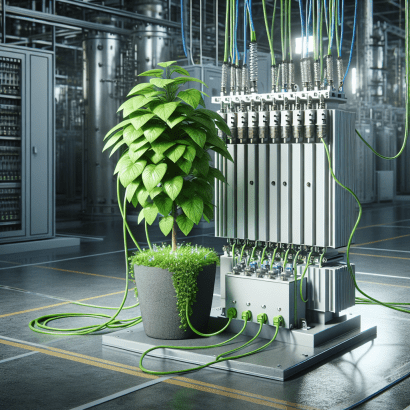
Research Shows Plants Are an Energy Source
Researchers found that plants can produce voltage. As the root system draws in water for nourishment, it creates electric potential that could be harnessed as an energy source. However, there’s a catch. Like all living things, vegetation has a biological clock — the natural 24-hour cycle known as the circadian rhythm that regulates internal processes.
During the day, greenery converts light energy into chemical energy in a process known as photosynthesis. It also absorbs water and nutrients from the soil. At night, its biological processes slow significantly.
How does a plant’s biological clock influence its electric potential? While scientists have studied how electricity works in vegetation for decades, this question has gone unanswered until now. The researchers hooked electrodes to water hyacinth stems and attached a reservoir — a system that stores electrical energy — and more electrodes to pieces of bamboo to find out.
They discovered plants repeatedly generate electrical potential on a consistent 24-hour cycle as liquid and sap flow. The voltage originates from the upward movement of ions — particles that conduct electricity — as they pass through the root system and into leaves.
These biological processes are based on Pascal’s law, which states that increasing the pressure on a confined fluid forces it to disperse equally in all directions. The larger the area, the more pressure is distributed. The flow of liquid creates streaming potential — voltage — as it travels through narrow conduits.
The Importance of This Discovery
This discovery is significant because it could accelerate the adoption of green energy sources. Currently, renewables account for just over 20% of the power in the United States — the rest is coal, nuclear and natural gas. Although the federal government is trying to increase its solar, wind and hydropower usage, its progression has been slow.
With wind turbines, hydropower facilities and solar panels, workers must engineer complex blueprints, mine raw materials and spend months on construction. For this plant-based energy, they’d simply need to plant seeds. Trees can easily live for hundreds of years once planted, making them one of the most sustainable long-term power sources.
Also, this research could help engineers develop biomimetic — meaning nature-inspired — structures. Either way, plants’ biological clocks create a unique opportunity for capturing energy naturally without adverse environmental impacts or local ecosystem disruption. This way, countries could address the global power crisis while mitigating climate change.
Potential Implementation Challenges
Research into harnessing sustainable energy from vegetation isn’t unprecedented. In the past, various research groups utilized photosynthesis to produce electricity. Those breakthroughs were arguably just as significant as the discovery that plants’ biological clocks affect streaming potential, but haven’t caught on.
Infrastructure Development Costs
Infrastructure development costs are one of the main reasons people aren’t already using plants to produce power. They would have to build new control and storage systems at scale since plants' biological processes produce voltage — the force pushing electric charges through a circuit to create a current — not electricity.
Lengthy Maturation Timeline
Many places have too few trees to accommodate their energy demands. Urban areas need more power but typically have sparse greenery. While planting seeds is easy, city planners would have to wait decades for them to mature. Companies won’t like the slow return on investment, meaning local and federal governments would have to take on such a project.
Scarce Natural Resource Usage
There’s also the issue of resource usage. Plants only create electric potential when they are alive and actively drawing water from the soil. Since over 99% of the planet’s water is unusable for most living things, scarcity is inevitable. City planners must create grey water recycling systems to ensure this power-harnessing technique remains sustainable.
These challenges shouldn’t be deal-breakers, even though overcoming them will be difficult. Decision-makers who plan ahead can pace their implementation strategy and offset potential unsustainable consequences. Getting enough mature trees to meet energy demands at scale may take years, but it’s possible.
What This Discovery Means for Energy
The discovery that plants’ biological clocks play a role in natural voltage generation encourages the federal government to abandon coal and natural gas. While greenery would take up roughly the same amount of space as a wind turbine or solar farm, it would be less costly to build and maintain. After all, trees heal themselves, and water falls from the sky.
Plant-Based Power
Trees actively remove carbon dioxide from the air, creating a healthy, oxygen-rich environment. They also filter airborne pollutants and promote biodiversity, providing a place for local ecosystems to thrive. Incorporating greenery into dense urban areas covered in glass, metal and concrete could be life-changing.
This kind of architecture already exists on a small scale. Living buildings — structures covered in plants — have been built in several cities worldwide. Engineers typically lay vegetation on top of a growing medium and a waterproof barrier. These creations can absorb or reflect up to 80% of the sun’s radiation in summer, combating climate change.
Climate-Friendly Energy
Research shows green roofs are up to 40 degrees Fahrenheit cooler during the day than conventional roofs. They also last twice as long on average because they must be built more structurally sound to withstand the increased load. They’re an effective way to deal with stormwater and combat climate change.
Since urban areas rarely have room for entire forests, engineers should expand on the concept of living buildings. Instead of developing giant parks, they could incorporate greenery into businesses, homes and offices. This would be huge since nearly 90% of people in the United States will live in urban areas by 2050.
Are Plants the Future of Energy?
This breakthrough discovery in plant-related electrokinetics is promising. It will likely remain in the academic field as other researchers expand on the concept and explore its implications. If it gains enough traction for decision-makers and policymakers to notice, it could become part of the country's renewable energy strategy.

